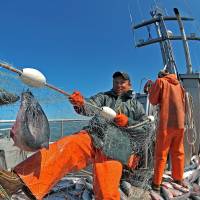A dispute over a proposed copper and gold mine near Alaska's Bristol Bay may be one of the most important environmental decisions of President Barack Obama's second term — yet few are even aware that the fight is happening.
At issue is a proposed mining operation in a remote area that is home to several Alaskan native tribes and nearly half of the world's sockeye salmon. Six tribes have asked the Environmental Protection Agency to invoke its powers under the Clean Water Act to block the mine on the grounds that it will harm the region's waterways, fish and wildlife.
The two mining firms behind the project, Northern Dynasty and Anglo American, have struck back with a major lobbying and public-relations campaign aimed at derailing any EPA intervention.
The Bristol Bay dispute has been largely overshadowed by the high-profile battle over the proposed Keystone XL oil pipeline from Canada to Texas, which has prompted strong opposition from environmental groups and which requires approval from the State Department to proceed.
Environmentalists argue the Bristol Bay project poses a serious threat to the area's delicate ecosystem and to the local fishing industry. Fishing businesses and tribal leaders, who have often quarreled, have banded together to oppose it. "If we don't protect this, we'll have nothing to fight over in the future," said Peter Andrew Jr., a board member of the Bristol Bay Native Corp. "This is the last place on Earth like this."
The Bristol Bay project will rank as the largest mine in North America if constructed and could eventually produce 36 billion kg of copper, 107 million ounces of gold and 2.5 billion kg of molybdenum.
In an early environmental assessment, the EPA estimates the mine will probably cause the loss of between 87 and 143 km of streams and between 10.3 and 18 sq. km of wetlands. Any accidents, the assessment continued, could result "in immediate, severe impacts on salmon and detrimental, long-term impacts on salmon habitat."
The EPA is still a long way from making a final decision on whether to block the mine, with hopes of finishing an assessment of the impact on the Nushagak and Kvichak watersheds by the end of the year. EPA Region 10 Administrator Dennis McLerran, who is overseeing the review, told reporters in late April that the agency "has made no decision about if or how it might use our authorities under the Clean Water Act, or other laws, to protect Bristol Bay."
The lobbying on the issue is already intense. The Pebble Limited Partnership — the joint venture by the two mining firms behind the project — spent more than $500,000 on lobbying last year and has spent at least $110,000 so far this year, according to federal disclosure records.
Environmental and tribal groups also have put significant resources into the fight. The Bristol Bay Native Corp. spent $110,000 in 2012 and $20,000 in 2013, according to public records. Last year, three environmental groups — the Nature Conservancy, the Natural Resources Defense Council and the League of Conservation Voters — spent $270,000, $82,000 and $20,000, respectively.
The Pebble mining partnership released an economic analysis Thursday estimating that the project will generate 2,500 construction jobs during the five years that it will take to build the facility. The report by IHS Global Insight predicted that the companies will spend approximately $1.2 billion per year on direct capital investment and wages during the construction phase and that the mine will eventually generate up to $180 million in annual taxes and royalties.
"For perspective, the report indicates Pebble development alone would pay more in annual taxes to the state than the entire fishing industry combined," Pebble Chief Executive John Shively said in a statement. "This clearly shows Pebble development could be an important economic driver for Alaska's future."
But a coalition of tribal, environmental and fishing groups questioned the analysis.
"Pebble has a well-established track record of understating the costs and risks associated with a giant open-pit mine at Bristol Bay's headwaters and exaggerating the benefits," said Tim Bristol, director of Trout Unlimited's Alaska program. Bristol said that 14,000 jobs depend on a healthy salmon fishery in the region.
One of the pivotal figures in the debate over the Bristol Bay mine is likely to be Alaska Democratic Sen. Mark Begich, who is up for re-election next year and has questioned whether the EPA should have the power to halt the project.
"While I remain opposed to a pre-emptive veto of this or any other project, an open, public process that answers Alaskans' questions and puts better science on the table is a good thing," Begich said when the EPA opened its public comment period in late April. "I hope the completed assessment will answer questions about whether this project can meet the high hurdle of developing a large-scale mine while protecting our renewable resources."



















With your current subscription plan you can comment on stories. However, before writing your first comment, please create a display name in the Profile section of your subscriber account page.